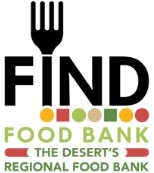Pass H.R.6613, Keeping School Meals Flexible Act
Congressional child nutrition waivers that allowed for free meals in school and other food assistance measures are expiring June 30. NBC News
If the waivers end this month as scheduled, experts foresee a crisis as families, already facing soaring prices at supermarkets, gas stations, and elsewhere, lose access to meals that their children have counted on for the last two years.
The waivers let families pick up multiple days’ worth of food to take home, without them students have to stay on-site to eat one meal, an obstacle for families who lack transportation and time.
If the waivers expire, 7 million kids could lose access to two meals a day. Food and Environmental Reporting Network
FIND Food Bank alongside Congressman Raul Ruiz, our partnering school districts, PSUSD, DSUSD, and CVUSD, as well as national, state, and local organizations, ask Congress to further extend USDA’s nationwide waiver authority through the school year 2022-23 to ensure USDA has continued flexibility to respond to the ongoing and evolving impacts of the pandemic as well as its aftermath and to ensure that the federal child nutrition programs continue to operate and provide healthy snacks and meals to students.
Join Us:
Take Action with Feeding America
Many rely on strong federal nutrition programs like the Supplemental Nutrition Assistance Program (SNAP), child nutrition programs like the Summer Food Service Program (SFSP), and federal commodity foods through The Emergency Food Assistance Program (TEFAP) and Commodity Supplemental Food Program (CSFP). Help advocate for federal nutrition programs with FIND and our network of 200+ Feeding America Food Banks working to fight hunger collectively in our communities.
Revisiones al Plan Thrifty Food de octubre de 2021
Los Beneficios de SNAP aumentarán un 27 por ciento por encima de los niveles prepandémicos, gracias a una revisión del Plan de Alimentos de Ahorro que controla las asignaciones máximas para SNAP o CalFresh en California.
El costo promedio de una comida en los EE. UU. Es $2.41, un 22 por ciento más alto que los beneficios máximos de cupones para alimentos, según un informe reciente del Urban Institute del que Waxman fue coautor. En 2020, el beneficio máximo no cubrió el costo de una comida a un precio modesto en el 96 por ciento de los condados de EE. UU. Sin embargo, la revisión reducirá esa cifra a aproximadamente el 21 por ciento de los condados.
"Esto es realmente importante para la adecuación de los beneficios de SNAP, pero todavía no hemos llegado al final". - Lisa Davis, vicepresidenta senior de No Kid Hungry
Aprenda sobre el hambre local
Niño y hambre de verano
- 22 million children receive free or reduced-cost lunches during the school year, but only 3.76 million continue to access those free meals in the summer. That’s where FIND’s Kids Summer Feeding Program steps in.
- 4 de 5 los niños pueden experimentar inseguridad alimentaria en la región desértica. Lo sabemos más de 83% of students qualify for free or reduced-price meals across the three regional school districts.
- ENCONTRAR feeds más de 60.000 niños por mes en nuestros mercados móviles y socios comunitarios. Los niños de 0 a 18 años comprenden 40% de la población total que ayudamos a alimentar.
Hambre rural
Rates of food insecurity among rural households are generally higher than in urban households. This is due to food deserts, which is an area that has limited access to fresh, nutritious food. While there might be a gas station or fast food nearby fresh produce can be hard to find. Data collected by Feeding America reveals that 84% of U.S. counties with the highest percentage of food-insecure children are rural.
- Mercado Campesinos, FIND’s direct food distribution to farmworkers, feeds 400-750 farmworkers and their families every other week at different locations across the Eastern Coachella Valley.
- Farmworkers face a multitude of obstacles to accessing nutritious foods:
- Falta de transporte confiable y aislamiento geográfico. Un trabajador agrícola puede tener que conducir 20 minutos o más para llegar a la tienda de comestibles saludables más cercana.
- La inseguridad de ingresos se debe a las temperaturas extremas y las temporadas bajas prolongadas para los trabajadores agrícolas; sin trabajo durante 2-3 semanas después de cosechar una cosecha significa que tienen que estirar esos salarios.
- El trabajo agrícola es un trabajo físicamente intensivo que deja a muchos inmóviles en su vejez e incapaces de mantenerse por sí mismos.
- Agriculture is the second-largest contributor to the Desert’s economy. Farmworkers produce over 50% of the United States’ fruits and vegetables.
In the Hi-Desert, FIND reaches area residents through our mobile market at Copper Mountain College, and a distribution branch in the Morongo Basin where surrounding food pantries and soup kitchens can pick up food for their clients. This saves them from making the hour-long trip down to the Coachella Valley to pick up food items.
Desechos alimentarios
- Un estimado 40% de alimentos cultivados, procesados y transportados en los EE. UU. nunca se consumirá.
- When food is disposed in a landfill it rots and becomes a significant source of methane – a potent greenhouse gas with serious side effects, including climate change.
- FIND es la organización de rescate de alimentos más grande del desierto. Nosotros rescatamos 9 millones de libras de comida en 2020!
- Esto impidió la liberación de aproximadamente 747,000 libras del gas de efecto invernadero metano a la atmósfera desde un vertedero.
Hambre mayor
- FIND alimentó a más de 23,000 adultos mayores en promedio cada mes en 2021.
- Los hogares de personas mayores tienen muchas menos probabilidades de recibir ayuda a través del Programa de Asistencia Nutricional Suplementaria (SNAP) que otros hogares, aunque los beneficios esperados son aproximadamente los mismos.
Hambre + Salud
- FIND Food Bank es un banco de alimentos saludables, nuestra distribución total es siempre 40-50% de productos frescos.
- Read about the benefits of consistent healthy meals on Feeding America’s blog, Hambre + Salud




